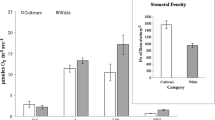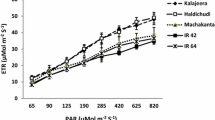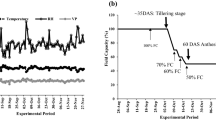Abstract
Main conclusion
Leaf biochemical capacity and the ratio of leaf biochemical capacity to stomatal conductance are promising to enhance leaf photosynthetic rate and water use efficiency in rice plants, respectively.
Abstract
Domestication may have great impact on crop photosynthetic rate, which has not been fully understood, especially from the perspective of stomatal conductance, mesophyll conductance, and leaf biochemical capacity simultaneously. In this study, we constructed a database consisting of 141 and 92 sets of data from wild and cultivated rice, respectively, including leaf gas exchange parameters, hydraulic conductance, structural traits, and nitrogen content. We found that, compared to wild rice, enhanced leaf photosynthetic rate in cultivated rice was mainly resulted by the increased stomatal conductance and leaf biochemical capacity, rather than mesophyll conductance. The unchanged mesophyll conductance observed during domestication suggested that it might have been optimized during plant evolution in wild rice. Additionally, the positive relationship between stomatal density and stomatal conductance disappeared in Oryza plants during domestication, suggesting that stomatal conductance in cultivated rice is less restricted by stomatal density, compared to wild rice. Moreover, in both wild and cultivated rice, leaf photosynthetic rate was mainly determined by leaf biochemical capacity, rather than stomatal conductance and mesophyll conductance. This study highlighted the important role of stomatal conductance and leaf biochemical capacity in improvement of leaf photosynthetic rate in rice during domestication. Leaf biochemical capacity and the ratio of leaf biochemical capacity to stomatal conductance should be further investigated to enhance leaf photosynthetic rate and water use efficiency in rice plants, respectively.






Similar content being viewed by others
Data availability
All data generated or analyzed during this study are included in this published article (and its supplementary information files).
References
Bernacchi CJ, Portis AR, Nakano H et al (2002) Temperature response of mesophyll conductance. Implications for the determination of Rubisco enzyme kinetics and for limitations to photosynthesis in vivo. Plant Physiol 130:1992–1998
Brodribb TJ (2009) Xylem hydraulic physiology: the functional backbone of terrestrial plant productivity. Plant Sci 177:245–251
Buckley TN (2005) The control of stomata by water balance. New Phytol 168:275–292
Buckley TN, John GP, Scoffoni C et al (2015) How does leaf anatomy influence water transport outside the xylem? Plant Physiol 168:1616–1635
Bunce J (2016) Variation among soybean cultivars in mesophyll conductance and leaf water use efficiency. Plants 5:44
Evans JR, Kaldenhoff R, Genty B et al (2009) Resistances along the CO2 diffusion pathway inside leaves. J Exp Bot 60:2235–2248
Falcioni R, Moriwaki T, Bonato CM et al (2017) Distinct growth light and gibberellin regimes alter leaf anatomy and reveal their influence on leaf optical properties. Environ Exp Bot 140:86–95
Feldman AB, Leung H, Baraoidan M et al (2017) Increasing leaf vein density via mutagenesis in rice results in an enhanced rate of photosynthesis, smaller cell sizes and can reduce interveinal mesophyll cell number. Front Plant Sci 8:1883
Flexas J (2016) Genetic improvement of leaf photosynthesis and intrinsic water use efficiency in C3 plants: why so much little success? Plant Sci 251:155–161
Flexas J, Diaz-Espejo A, Galmes J et al (2007) Rapid variations of mesophyll conductance in response to changes in CO2 concentration around leaves. Plant Cell Environ 30:1284–1298
Flexas J, Niinemets Ü, Gallé A et al (2013) Diffusional conductances to CO2 as a target for increasing photosynthesis and photosynthetic water-use efficiency. Photosyn Res 117:45–59
Flexas J, Díaz-Espejo A, Conesa MA et al (2016) Mesophyll conductance to CO2 and Rubisco as targets for improving intrinsic water use efficiency in C3 plants. Plant Cell Environ 39:965–982
Flexas J, Clemente-Moreno MJ, Bota J et al (2021) Cell wall thickness and composition are involved in photosynthetic limitation. J Exp Bot 72:3971–3986
Franks PJ, Beerling DJ (2009) Maximum leaf conductance driven by CO2 effects on stomatal size and density over geologic time. Proc Natl Acad Sci USA 106:10343–10347
Franks PJ, Drake PL, Beerling DJ (2009) Plasticity in maximum stomatal conductance constrained by negative correlation between stomatal size and density: an analysis using Eucalyptus globulus. Plant Cell Environ 32:1737–1748
Fuller DQ (2007) Contrasting patterns in crop domestication and domestication rates: recent archaeobotanical insights from the Old World. Ann Bot 100:903–924
Gago J, Douthe C, Florez-Sarasa I et al (2014) Opportunities for improving leaf water use efficiency under climate change conditions. Plant Sci 226:108–119
Gago J, Carriquí M, Nadal M et al (2019) Photosynthesis optimized across land plant phylogeny. Trends Plant Sci 24:947–958
González A, Lynch J, Tohme JM et al (1995) Characters related to leaf photosynthesis in wild populations and landraces of common bean. Crop Sci 35:1468–1476
Gross BL, Zhao Z (2014) Archaeological and genetic insights into the origins of domesticated rice. Proc Natl Acad Sci USA 111:6190–6197
Hanba YT, Miyazawa SI, Terashima I (1999) The influence of leaf thickness on the CO2 transfer conductance and leaf stable carbon isotope ratio for some evergreen tree species in Japanese warm-temperate forests. Funct Ecol 13:632–639
Huang G, Peng S, Li Y (2022a) Variation of photosynthesis during plant evolution and domestication: implications for improving crop photosynthesis. J Exp Bot 73:4886–4896
Huang G, Shu Y, Peng S et al (2022b) Leaf photosynthesis is positively correlated with xylem and phloem areas in leaf veins in rice (Oryza sativa) plants. Ann Bot 129:619–631
Huang G, Yang Y, Zhu L et al (2022c) The structural correlations and the physiological functions of stomatal morphology and leaf structures in C3 annual crops. Planta 256:39
Kovach MJ, Sweeney MT, McCouch SR (2007) New insights into the history of rice domestication. Trends Genet 23:578–587
Lehmeier C, Pajor R, Lundgren MR et al (2017) Cell density and airspace patterning in the leaf can be manipulated to increase leaf photosynthetic capacity. Plant J 92:981–994
Lei Z, Liu F, Wright IJ et al (2021) Comparisons of photosynthetic and anatomical traits between wild and domesticated cotton. J Exp Bot 73:873–885
Lei Z, Westerband AC, Wright IJ et al (2022) Leaf trait covariation and controls on leaf mass per area (LMA) following cotton domestication. Ann Bot 130:231–243
Lei Z, He Y, Li X et al (2023) Domestication has reduced leaf water use efficiency associated with the anatomy of abaxial stomata in cotton. J Exp Bot 74:878–888
Long SP, Bernacchi CJ (2003) Gas exchange measurements, what can they tell us about the underlying limitations to photosynthesis? Procedures and sources of error. J Exp Bot 54:2393–2401
Long SP, Marshall-Colon A, Zhu XG (2015) Meeting the global food demand of the future by engineering crop photosynthesis and yield potential. Cell 161:56–66
Milla R, Matesanz S (2017) Growing larger with domestication: a matter of physiology, morphology or allocation? Plant Biol 19:475–483
Milla R, de Diego-Vico N, Martín-Robles N (2013) Shifts in stomatal traits following the domestication of plant species. J Exp Bot 64:3137–3146
Milla R, Morente-López J, Alonso-Rodrigo JM et al (2014) Shifts and disruptions in resource-use trait syndromes during the evolution of herbaceous crops. P Roy Soc B-Biol Sci 281:20141429
Molina J, Sikora M, Garud N et al (2011) Molecular evidence for a single evolutionary origin of domesticated rice. Proc Natl Acad Sci USA 108:8351–8356
Nadal M, Flexas J (2019) Variation in photosynthetic characteristics with growth form in a water-limited scenario: implications for assimilation rates and water use efficiency in crops. Agricul Water Manage 216:457–472
Niinemets Ü (1999) Research review. Components of leaf dry mass per area–thickness and density–alter leaf photosynthetic capacity in reverse directions in woody plants. New Phytol 144:35–47
Poorter H, Remkes C (1990) Leaf area ratio and net assimilation rate of 24 wild species differing in relative growth rate. Oecologia 83:553–559
Ren T, Weraduwage SM, Sharkey TD (2019) Prospects for enhancing leaf photosynthetic capacity by manipulating mesophyll cell morphology. J Exp Bot 70:1153–1165
Sack L, Scoffoni C, Johnson DM et al (2015) The anatomical determinants of leaf hydraulic function. In: Hacke U (ed) Functional and ecological xylem anatomy. Springer, Cham, pp 255–271
Sage TL, Sage RF (2009) The functional anatomy of rice leaves: implications for refixation of photorespiratory CO2 and efforts to engineer C4 photosynthesis into rice. Plant Cell Physiol 50:756–772
Tanaka Y, Sugano SS, Shimada T et al (2013) Enhancement of leaf photosynthetic capacity through increased stomatal density in Arabidopsis. New Phytol 198:757–764
Terashima I, Hanba YT, Tholen D et al (2011) Leaf functional anatomy in relation to photosynthesis. Plant Physiol 155:108–116
Xiong D, Flexas J (2018) Leaf economics spectrum in rice: leaf anatomical, biochemical, and physiological trait trade-offs. J Exp Bot 69:5599–5609
Xiong D, Yu T, Zhang T et al (2015) Leaf hydraulic conductance is coordinated with leaf morpho-anatomical traits and nitrogen status in the genus Oryza. J Exp Bot 66:741–748
Xiong D, Wang D, Liu X et al (2016) Leaf density explains variation in leaf mass per area in rice between cultivars and nitrogen treatments. Ann Bot 117:963–971
Xiong D, Douthe C, Flexas J (2018) Differential coordination of stomatal conductance, mesophyll conductance, and leaf hydraulic conductance in response to changing light across species. Plant Cell Environ 41:436–450
Zhu XG, Long SP, Ort DR (2010) Improving photosynthetic efficiency for greater yield. Ann Rev Plant Biol 61:235–261
Acknowledgements
This research was supported by the Jiangxi Provincial Science and Technology Plan Projects (GJJ2200428).
Funding
Jiangxi Provincial Science and Technology Plan Projects, GJJ2200428, Guanjun Huang.
Author information
Authors and Affiliations
Contributions
GH: conceived and designed the research; GH: collected and analyzed the data and wrote the paper; YZ: commented on and revised the paper.
Corresponding author
Additional information
Communicated by Dorothea Bartels.
Publisher's Note
Springer Nature remains neutral with regard to jurisdictional claims in published maps and institutional affiliations.
Supplementary Information
Below is the link to the electronic supplementary material.
Rights and permissions
Springer Nature or its licensor (e.g. a society or other partner) holds exclusive rights to this article under a publishing agreement with the author(s) or other rightsholder(s); author self-archiving of the accepted manuscript version of this article is solely governed by the terms of such publishing agreement and applicable law.
About this article
Cite this article
Huang, G., Zeng, Y. Increased stomatal conductance and leaf biochemical capacity, not mesophyll conductance, contributing to the enhanced photosynthesis in Oryza plants during domestication. Planta 259, 28 (2024). https://doi.org/10.1007/s00425-023-04305-x
Received:
Accepted:
Published:
DOI: https://doi.org/10.1007/s00425-023-04305-x




